|
Ken Butler's Plants
kbutler243@aol.com
Added June 2004
Cow Parsley (Anthriscus
sylvestris)
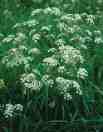 This common plant adorns
the roadsides and hedgerows during June. It is two to four feet high and
has feathery fern-like mid-green leaves. It likes fertile ground and is
not harmed by the wind or salt by the sea. It is very resistant to
herbicides, so prospers when roadworkers spray the verge to eliminate
the weeds. It should not be confused with Sweet Cicely which does also
grow by roadsides but flowers earlier, has lighter green ferny leaves
and smells of aniseed. Nor is it Hedge Parsley, which does not grow in
Caithness. This common plant adorns
the roadsides and hedgerows during June. It is two to four feet high and
has feathery fern-like mid-green leaves. It likes fertile ground and is
not harmed by the wind or salt by the sea. It is very resistant to
herbicides, so prospers when roadworkers spray the verge to eliminate
the weeds. It should not be confused with Sweet Cicely which does also
grow by roadsides but flowers earlier, has lighter green ferny leaves
and smells of aniseed. Nor is it Hedge Parsley, which does not grow in
Caithness.
Marsh Thistle (Cirsium
palustre)
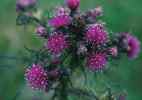 There are three common species of thistle in Caithness. The marsh
thistle often has dark blue-green leaves and it lives in wet places. It
is to be seen in marshes and the banks of burns and rivers. Its base has
a distinct rosette of leaves, while the other common thistles do not. There are three common species of thistle in Caithness. The marsh
thistle often has dark blue-green leaves and it lives in wet places. It
is to be seen in marshes and the banks of burns and rivers. Its base has
a distinct rosette of leaves, while the other common thistles do not.
Few-flowered Garlic (Allium paradoxum)
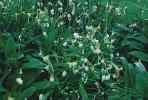 This is an alien plant to Britain, coming from the Caucasus. It has been
brought in by a gardener and put out onto the verge in Miller Avenue,
Wick where it has become vigorously naturalised and is spreading. It
shows its pretty white flowers in Spring when little else is in flower.
However it is not recommended as a garden flower because it is too
vigorous and will take over the garden. This is an alien plant to Britain, coming from the Caucasus. It has been
brought in by a gardener and put out onto the verge in Miller Avenue,
Wick where it has become vigorously naturalised and is spreading. It
shows its pretty white flowers in Spring when little else is in flower.
However it is not recommended as a garden flower because it is too
vigorous and will take over the garden.
Salmonberry (Rubus spectabilis)

This plant, alien to Britain, has escaped from gardens and invaded the
surrounding land to become a serious nuisance in a few places. It has a
strong presence at Olrig and at Latheronwheel and a lesser occurrence in
a few other places. The beautiful pink-magenta flowers come out in May
and they develop fruits that look like yellow raspberries in the late
summer. There are those who pick the fruit for jam or winemaking but
they are not to my taste!
Sweet Cicely (Myrrhis odorata)
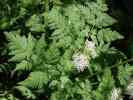 In May the Sweet Cicely throws up its light green fern-like leaves and
puts out its umbels of tiny white flowers. It is not a native plant of
Caithness but has been imported into gardens for its value as a herb
with a strong aniseed taste and smell. It came from the mountainous
areas of Europe - the Pyrenees and Central Alps - and has established
itself along the hedgerows of Scotland and northern England. It often
grows with or displaces the more common Cow Parsley in our hedgerows. In May the Sweet Cicely throws up its light green fern-like leaves and
puts out its umbels of tiny white flowers. It is not a native plant of
Caithness but has been imported into gardens for its value as a herb
with a strong aniseed taste and smell. It came from the mountainous
areas of Europe - the Pyrenees and Central Alps - and has established
itself along the hedgerows of Scotland and northern England. It often
grows with or displaces the more common Cow Parsley in our hedgerows.
Twayblade (Listera ovata)
 The Twayblade orchid likes well drained calcium-rich soil, so it occurs
commonly on dune links turf such as at Dunnet, Sandside and Keiss, but
it is scattered more widely across the county where the environment is
suitable. It is usually about ten inches high and has green leaves and
green flowers, so you have to look hard to notice it amongst the other
greenery. But it is distinctive and easy to recognise. There are two
large, oval, opposite green leaves at the base of the plant - hence the
plant's name - and the small green flowers are shaped like a small green
man, with a head, two legs and two arms. The Twayblade orchid likes well drained calcium-rich soil, so it occurs
commonly on dune links turf such as at Dunnet, Sandside and Keiss, but
it is scattered more widely across the county where the environment is
suitable. It is usually about ten inches high and has green leaves and
green flowers, so you have to look hard to notice it amongst the other
greenery. But it is distinctive and easy to recognise. There are two
large, oval, opposite green leaves at the base of the plant - hence the
plant's name - and the small green flowers are shaped like a small green
man, with a head, two legs and two arms.
Hazel Catkins (Corylus avellana)
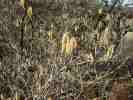 Catkins are the male flowers of the hazel bush. They are adapted to
spread their pollen on the wind and the catkin tassels shake in the
breeze to aid dispersal. They appear in May. The female flowers are on
the same bush and they are very small and inconspicuous except for a
bright red stigma that captures the pollen. Hazel grows where the soil
is particularly rich in minerals. Catkins are the male flowers of the hazel bush. They are adapted to
spread their pollen on the wind and the catkin tassels shake in the
breeze to aid dispersal. They appear in May. The female flowers are on
the same bush and they are very small and inconspicuous except for a
bright red stigma that captures the pollen. Hazel grows where the soil
is particularly rich in minerals.
Fragrant Orchid (Gymnadenia conopsea)
 This pink orchid is very fragrant, so bend down and have a sniff! There
are very few pink orchids in Caithness so if you see one it is probably
this one. Its flowers are smallish and neat with the side petals held
almost horizontal. It likes ground with a good supply of minerals, but
it can be dry or wet ground This pink orchid is very fragrant, so bend down and have a sniff! There
are very few pink orchids in Caithness so if you see one it is probably
this one. Its flowers are smallish and neat with the side petals held
almost horizontal. It likes ground with a good supply of minerals, but
it can be dry or wet ground
Scotch Rose or Burnet Rose (Rosa pimpinellifolia)
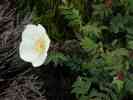 This is the easiest Caithness rose to identify. It has many fine
prickles instead of the usual strong spines of other roses. Its flowers
are white and the hips are purple-black. This is the easiest Caithness rose to identify. It has many fine
prickles instead of the usual strong spines of other roses. Its flowers
are white and the hips are purple-black.
It likes living by the coast and on rocky ground and normally grows only
two feet tall. It crosses with other roses occasionally to produce
offspring which have red hips and are usually taller.
|



















